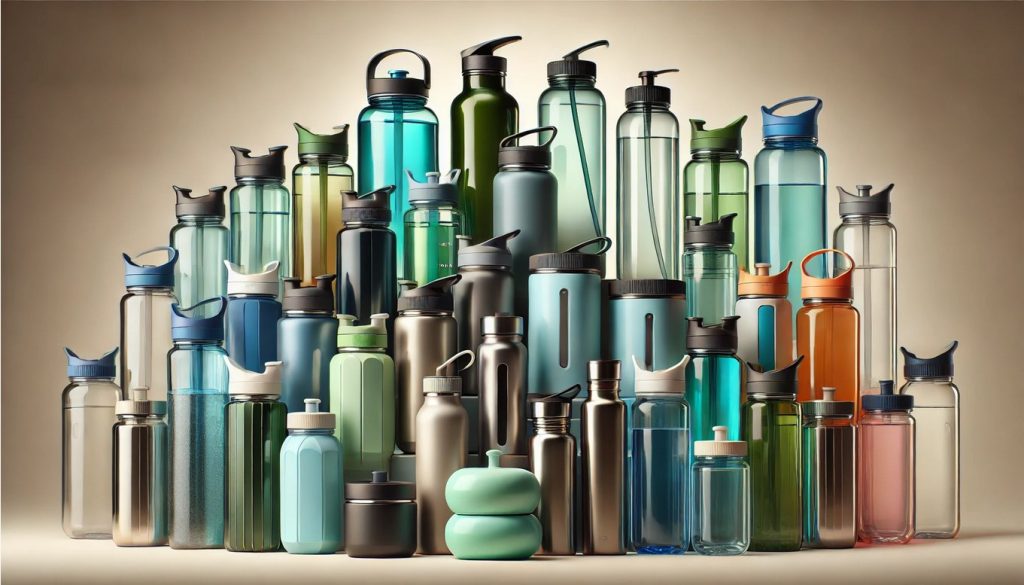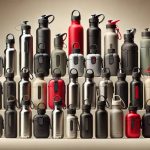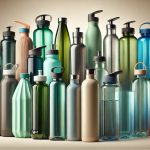Water containers are crucial tools for storing, transporting, and accessing water in a variety of situations. Whether it’s for outdoor adventures, emergency preparedness, or daily use at home, having a reliable and functional water container can make a significant difference. The variety of water containers available today makes it easier than ever to find one that meets your specific needs.
Types of Multi-Purpose Water Containers
Multi-purpose water containers come in several different types, each offering specific advantages based on the circumstances in which they’re used. Depending on how much water you need to store, how often you’ll be moving the container, and where you’ll be using it, your choice of container can vary widely.
Collapsible Water Containers
Collapsible water containers are designed for people who need an easy-to-store, portable option for water storage. These containers can be folded, rolled, or compressed to a fraction of their size, which makes them perfect for situations where space is limited.
Features of Collapsible Water Containers
- Compact Design: The primary benefit of collapsible containers is their ability to fold into a small form, making them ideal for situations where storage space is at a premium.
- Lightweight: Most collapsible containers are made from lightweight materials that don’t add much extra weight to your gear. This makes them especially useful for outdoor activities like camping and hiking.
- Flexible Materials: These containers are usually made from flexible fabrics like PVC, nylon, or food-grade polyethylene that can withstand pressure but remain lightweight and portable.
- Convenient for Transport: Many collapsible containers feature carry handles or straps, allowing for easy handling during transport.
Common Uses of Collapsible Water Containers
- Camping and Hiking: Ideal for outdoor adventures where space and weight are key factors.
- Emergency Preparedness: These containers are often included in emergency kits, as they can be easily packed away until needed.
- Picnics and Travel: They are also useful for short trips where portable hydration is necessary, such as on a day trip or road journey.
Rigid Water Containers
Rigid water containers are designed for durability and long-term use. Made from sturdy, inflexible materials like plastic or metal, these containers are well-suited for holding large amounts of water without the risk of collapsing under pressure.
Features of Rigid Water Containers
- Durability: Rigid containers are more resistant to physical damage compared to their collapsible counterparts. They can withstand drops, punctures, and rough handling without being damaged.
- Stable Storage: They provide a more stable environment for water storage, which is important when the container is placed on uneven surfaces.
- Variety of Sizes: Rigid containers come in a broad range of sizes, from small jugs that hold a few liters of water to large tanks that can store hundreds of gallons.
- Long-lasting Construction: Typically made from high-density polyethylene (HDPE), stainless steel, or other robust materials, rigid containers can last for many years when properly maintained.
Common Uses of Rigid Water Containers
- Home and Office Use: These containers are often used to supply clean drinking water in homes or offices.
- Agricultural Applications: They are suitable for irrigation, storing water for livestock, or industrial uses where large volumes of water are needed.
- Disaster Relief: Large rigid containers are used in disaster scenarios to store and distribute water to affected populations.
Water Bladders
Water bladders are a unique solution for large-scale water storage. These flexible bags can hold large volumes of water, yet remain easy to store and move when empty.
Features of Water Bladders
- High Capacity: Water bladders come in sizes ranging from 10 liters to over 1000 liters, making them ideal for bulk water storage.
- Flexibility: Water bladders are typically made from flexible materials like PVC or food-grade polyethylene, allowing them to expand when filled and shrink when emptied for easy storage.
- Space-efficient: When not in use, water bladders can be folded into small, compact sizes, making them suitable for storage in tight spaces.
- Portable: Although large, water bladders are designed to be lightweight when empty, and many feature handles or straps to facilitate transport.
Common Uses of Water Bladders
- Emergency Preparedness: Water bladders are commonly used in emergency situations, providing a large, portable source of water for individuals, families, or communities.
- Agriculture: Water bladders are frequently used to collect rainwater or to store water for irrigation purposes on farms.
- Camping and RVing: They are used by campers or RVers who need a large supply of water but lack traditional plumbing.
Materials Used in Multi-Purpose Water Containers
The material from which a water container is made is a key factor in determining its durability, safety, and functionality. Each material has its strengths and weaknesses, and the best option for you will depend on your specific needs and intended use.
Plastic Water Containers
Plastic is one of the most popular materials for water containers because it is lightweight, durable, and inexpensive. There are several types of plastic commonly used in water containers, each with its specific advantages.
Types of Plastic Used in Water Containers
- HDPE (High-Density Polyethylene): Known for its strength, flexibility, and resistance to chemicals, HDPE is commonly used for rigid water containers. It is also UV-resistant, which makes it suitable for outdoor storage.
- LDPE (Low-Density Polyethylene): This type of plastic is more flexible than HDPE and is commonly used for collapsible water containers. While it is less durable than HDPE, it remains a cost-effective and lightweight option.
- Polypropylene (PP): Another strong plastic, polypropylene is resistant to heat and chemicals. It is used in containers that may be exposed to high temperatures or harsh chemicals.
- Polycarbonate: Strong and clear, polycarbonate is used for containers that need to withstand higher pressures. However, polycarbonate containers can be more expensive and are susceptible to scratches and cracks.
Pros of Plastic Water Containers
- Affordability: Plastic containers are often more budget-friendly than other options.
- Lightweight: They are easy to carry, making them ideal for outdoor activities.
- Variety: Plastic can be molded into a variety of shapes, making it possible to find a container suited to almost any need.
Cons of Plastic Water Containers
- Chemical Leaching: Some plastics can leach chemicals into the water over time, especially when exposed to heat or sunlight. This is particularly true for lower-quality plastics.
- Environmental Concerns: Plastic containers contribute to environmental waste, as they are not biodegradable and can take centuries to decompose.
Stainless Steel Water Containers
Stainless steel is another popular material for water containers, known for its robustness, longevity, and resistance to corrosion.
Features of Stainless Steel Containers
- Durability: Stainless steel containers are highly resistant to rust, corrosion, and dents, making them perfect for long-term use.
- Non-toxic: Unlike plastic containers, stainless steel doesn’t leach chemicals into the water. This makes it a great choice for drinking water storage.
- Temperature Retention: Many stainless steel containers are designed with insulation, allowing them to keep water cold for extended periods.
- Aesthetic Appeal: Stainless steel containers are sleek and stylish, often favored for use in homes and offices.
Pros of Stainless Steel Water Containers
- Longevity: These containers are designed to last for decades, even with frequent use.
- Non-reactive: Stainless steel is a neutral material, which means it won’t affect the taste of the water or leach harmful substances.
- Resistant to Punctures: Unlike plastic, stainless steel is less likely to be damaged by rough handling.
Cons of Stainless Steel Water Containers
- Heavier than Plastic: Stainless steel containers are significantly heavier than their plastic counterparts, which can make them less convenient for certain activities.
- Higher Cost: The initial cost of a stainless steel water container is typically higher than plastic containers, although it’s an investment that can last much longer.
Glass Water Containers
Glass containers are another option, particularly valued for their purity and aesthetic appeal. While not as common for outdoor use, glass water containers offer a chemical-free and sustainable choice for storing water.
Features of Glass Containers
- Chemical-Free: Glass is an inert material, meaning it won’t interact with the water or leach chemicals. This makes it one of the purest materials for water storage.
- Recyclable: Glass is 100% recyclable, making it a more environmentally friendly option than plastic.
- Aesthetic Appeal: Glass containers often look elegant and are commonly used for serving or storing drinking water in kitchens or dining areas.
Pros of Glass Water Containers
- Purity: Glass does not affect the taste or quality of the water, making it ideal for long-term water storage.
- Sustainability: Glass containers can be reused or recycled indefinitely without losing their integrity.
- Aesthetic Value: Many people choose glass containers for their homes because of their sleek, modern look.
Cons of Glass Water Containers
- Fragility: Glass is prone to breakage when dropped, making it less practical for outdoor use or transport.
- Heavier: Glass containers can be much heavier than plastic, reducing their portability for certain activities.
Factors to Consider When Choosing a Water Container
Choosing the right water container depends on several factors, from the material and size to the container’s intended use. Here are some considerations to keep in mind when making your decision.
Capacity
The capacity of the water container is a primary consideration. Depending on whether you need a small, portable container or a large storage tank, you can find a variety of options. Containers come in sizes ranging from a few liters to hundreds of liters, so understanding your needs will help you choose the right size.
Portability
If you plan to transport your water container, portability becomes a key factor. Collapsible or lightweight containers are the best options for hiking, camping, or emergency preparedness, while rigid containers are better suited for stationary use or long-term water storage.
Durability
Durability is essential, especially if the container will be exposed to extreme conditions or rough handling. Stainless steel and HDPE offer the best durability, while plastic containers may be more prone to cracking or degrading over time.
Ease of Use and Maintenance
Look for containers with easy-to-use features, such as spouts for pouring, built-in handles for carrying, and wide mouths for easy filling and cleaning. Containers made of stainless steel or glass are easier to maintain and clean, while plastic containers may require more frequent cleaning to prevent bacterial growth.
Intended Purpose
Whether you need a container for personal hydration, emergency water storage, or industrial use will influence your choice. For personal use, smaller, portable containers may be suitable, while larger, more robust containers may be necessary for long-term or industrial applications.
Price
Consider your budget when selecting a water container. While plastic containers are generally the most affordable, high-quality stainless steel or glass options may be more expensive but offer greater durability and safety.
Additional Features
Some water containers come with extra features like filtration systems, UV protection, or insulation to keep water at the desired temperature. These features can add value to a container, depending on your needs.







